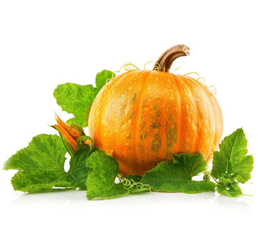Pumpkin
Pumpkin is the generic name of plants of the family Cucurbitaceae. Pumpkin can be annual or multi-year. Leaves large, hairy gourd or hard-rough, its branches stelâŝiesâ or clinging. During flowering, the plant is covered with large flowers, white or yellow in colour. Fruit large, Pumpkins have often reach large size: from 2 to 9-ти kg. Only nature has about 10-minute wild types of pumpkins. They grow in warm climates in many countries. Cultivate pumpkins aren’t just for eating the fruit, but also with a decorative purpose. Uncleaned and uncuted pumpkin long, so since ancient times used in farms.
Birthplace of pumpkin believe the territory of modern Mexico, where it grew more than 3 thousand. BC (kalorizator). The first American settlers had cut the top off the pumpkin, remove the seeds, filled the inside of milk, spices and honey, then bake the pumpkin in hot ashes, and roasted pumpkin slices Indians at the stake, and from strips of dried pumpkins made mats.
In Europe the pumpkin got in the middle of the 16th century, when, like many other useful plants, brought the Spaniards. Pumpkin first cultivated in the southern countries, but gradually expanded its distribution area and the colder countries, including Ukraine and Russia. Currently cultivated species grow pumpkins in most countries of the world.
Calorie pumpkin
Calorie pumpkin is 28 kcal per 100 grams of product.
Composition of pumpkin
Pumpkin is a kind of natural vitamin-mineral complex. Champion among vitamins contained in pumpkin, is beta carotene, pumpkin is rich in vitamins c, e, B1, B2, pp. There are lots of potassium, calcium, iron, magnesium, copper, zinc, cobalt, silicon and fluorine.
Besides pumpkins are rich in fiber and low in energy. By quantity of carotene pumpkin close to carrots. Pumpkin seeds is useful too, they contain fats, proteins, vitamins and mineral salts.
Useful properties of pumpkin
Pumpkin has a number of useful properties. Despite the fact that 90% is composed of water, pumpkin is a good source of carotene, vitamins, that especially need to keep in mind people suffering from cardiovascular diseases.
Particularly rich in vitamin e, help from premature senility and zinc salts, which are necessary for the normal development of the male body.
The pumpkin is a vegetable diet. Due to the low content of its flesh rough fiber and organic acids, pumpkin can be eaten even in inflammatory diseases of the stomach and intestines. It is also useful for iron-deficiency anaemia because it contains a complex of mineral substances involved in blood formation (iron, copper, cobalt, zinc).
Due to the high content of potassium pumpkin improves heart, strengthens blood vessels and relieves edema. Liver diseases it is recommended to eat as much raw pumpkin flesh, and if crude pumpkin seems tasteless, you can replace it with pumpkin meat with rice, millet or decoy.
Well, that pumpkin seeds is a recognized means for expelling intestinal worms, known to almost everyone (calorizator). But because the dried pumpkin seeds often given to children to prevent similar troubles.
Pumpkin in cooking
There are many ancient dishes of Russian cuisine, including pumpkin.
Edible varieties of pumpkins (as opposed to decorative) are eaten after processing: pumpkin boiled, baked, etc This pumpkin very well digested and widely used even for children’s and dietary meals. Also good is used in salads, soups, desserts and side dishes. Fruit pulp is soft and firm, varying consistency. From it is good to cook casseroles and rice porridge, millet.


Leave a Comment